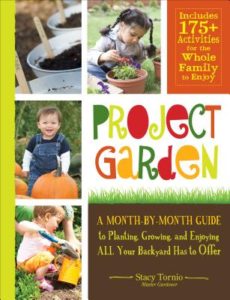23 Mar Composting with Kids
 We are excited to have this guest post from Stacy Tornio (www.stacygrows.com) the author of “Project Garden: A Month by Month Guide to Planting, Growing, and Enjoying All Your Backyard Has to Offer” a fantastic new book which includes over 175 activities for the whole family to enjoy! I’ve been enjoying it and found that there are so many fantastic and creative ideas that kids will love. Check out how to win a copy of her new book < here >
We are excited to have this guest post from Stacy Tornio (www.stacygrows.com) the author of “Project Garden: A Month by Month Guide to Planting, Growing, and Enjoying All Your Backyard Has to Offer” a fantastic new book which includes over 175 activities for the whole family to enjoy! I’ve been enjoying it and found that there are so many fantastic and creative ideas that kids will love. Check out how to win a copy of her new book < here >
Composting with Kids
Truth be told, I don’t exactly find composting an “easy” activity for kids. I think it can involve a lot—finding the right space, knowing what is and isn’t okay to compost and having the patience for it all to turn into soil.
Yet, I regularly teach a composting class to kids through my volunteer work as a master gardener. How come?
The thing is, kids love it. I mean, what’s more magical than throwing your garbage into a bin and then it turns into soil? So to make composting with kids easier, here are a few suggestions:
Explain what’s happening. Make sure to tell the kids what’s going on throughout this process. There are some great books out there that explain what you should and should not compost (Compost Stew is a wonderful picture book). Depending on what age of kids you’re working with, make sure they understand what’s happening.
Find a good tumbler system. Old school composting systems involve a lot of turning and mixing by hand. But if you’re composting with kids, I recommend getting a good tumbler system. They’ll like to spin it, and it speeds up the process.
Learn the difference between brown and green. If you don’t get this part right, then nothing else matters. It’s easy to come up with green matter like kitchen waste, but don’t forget to add brown matter like leaves and cardboard. The general rule of thumb is you need about 25 to 30 parts brown material to one part green. (To learn what is and isn’t okay to compost, take a look at my video.)
Designate a spot. You definitely need a spot to keep your compost pile or bin outside, but also designate a place to keep your kitchen scraps. They make some bins, complete with compostable, odor-eliminating liners that are great. If you have it out where everyone can see, you’re more likely to keep doing it.
Experiment with worms. Worms speed up the composting process, and kids love them! When I teach composting classes, we create mini environments with red wiggler worms, shredded newspaper and soil. In the gardening world, it’s called vermicomposting. Check it out!
Recycle, recycle, recycle. The bottom line is that composting is a great way to recycle. Don’t lose sight of that. Even if you’re not successful right away or it’s a lot more involved than you imagined it to be, you can still use it as a way to recycle more. It’s still a worthwhile lesson.
It’s okay to take a break. Many people stop composting in winter (if they live in a colder climate) or find that they go in spurts. This is okay! Don’t try to do too much, and take a break if you need it.


